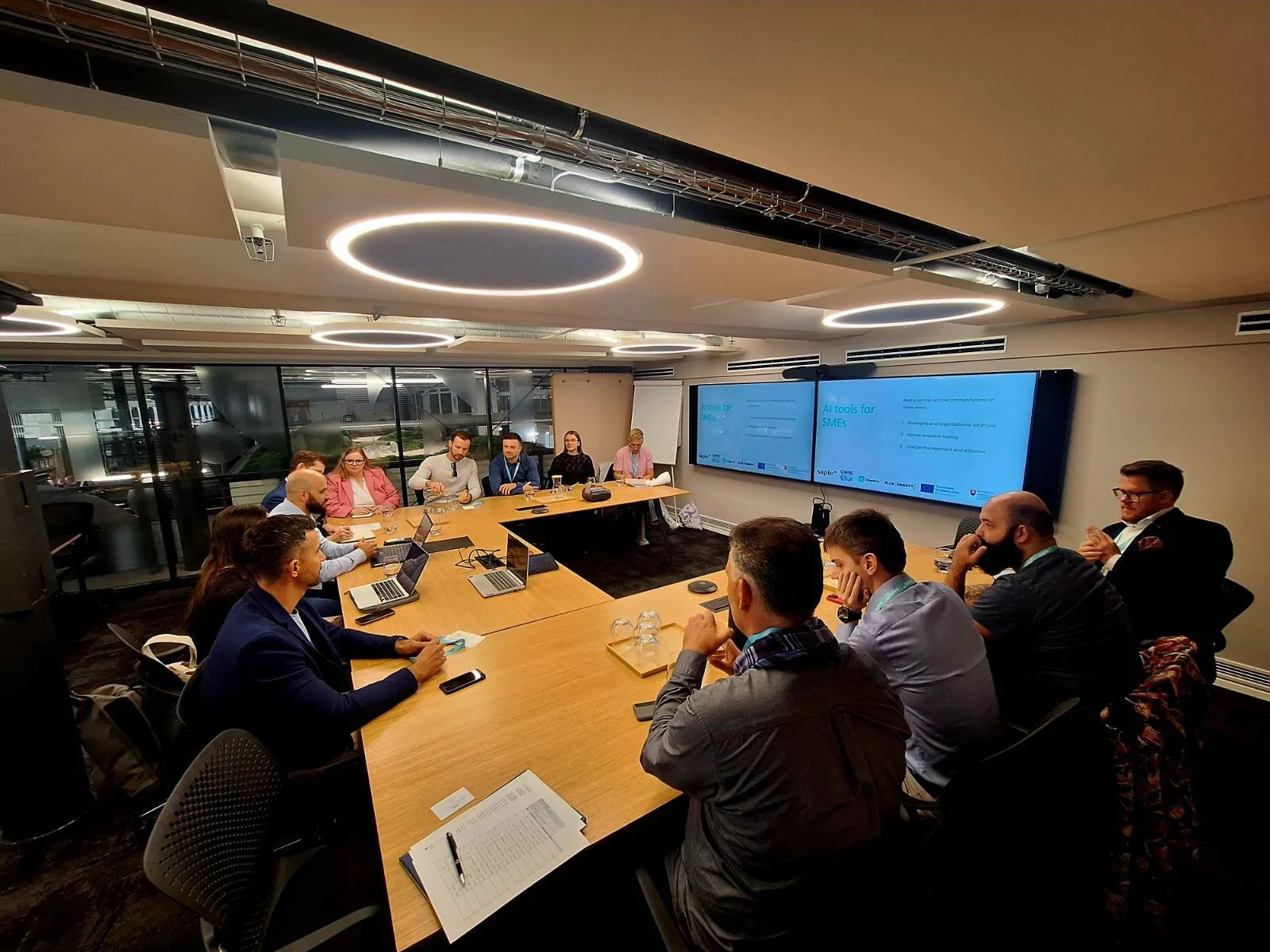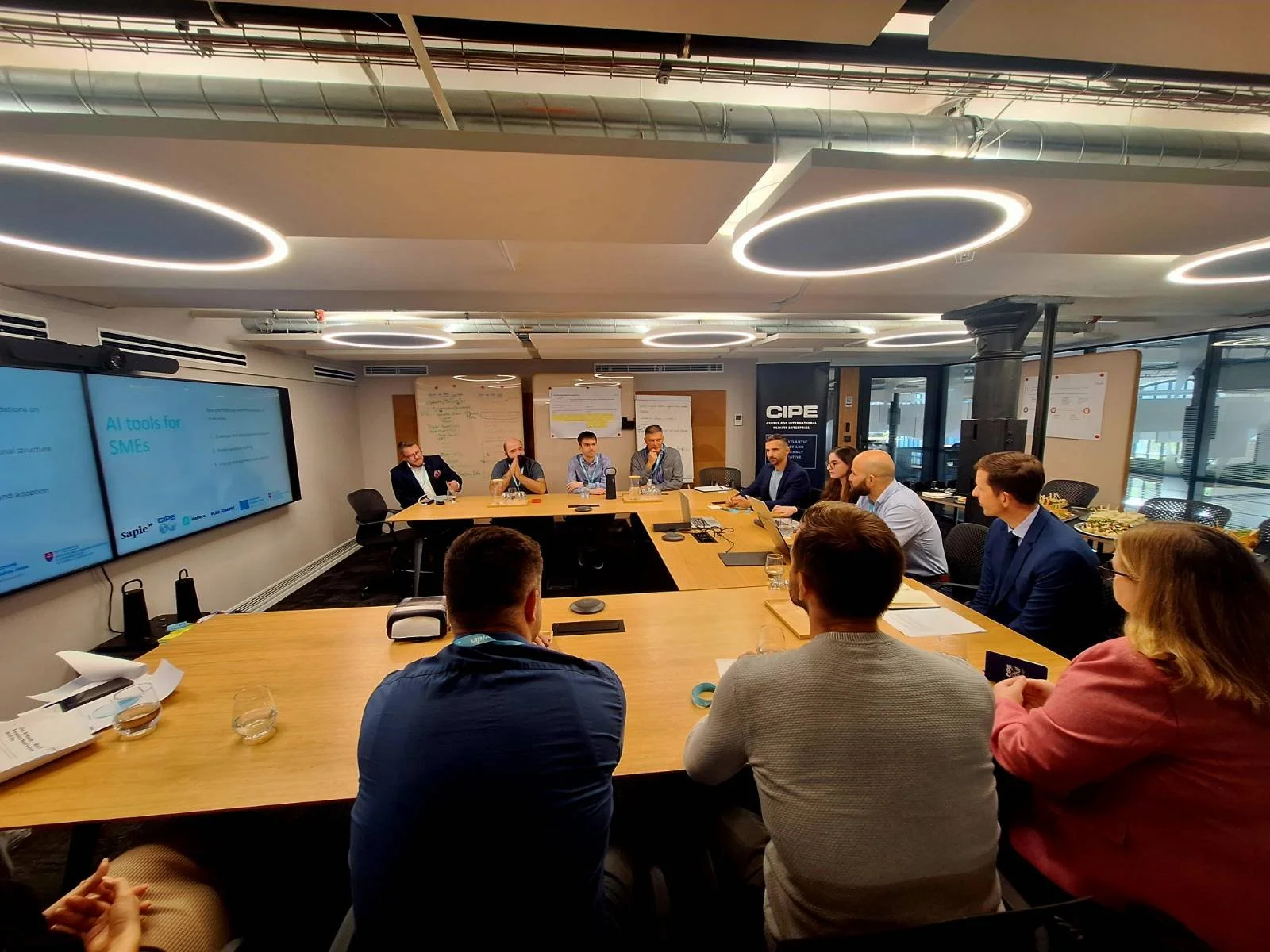Summary: AI tools for SMEs?
AI has been a phenomenon since ChatGPT entered the market. It is the technology that helps businesses in almost every area of process automation, including saving their resources.
During the discussion which took place on the sidelines of the SAPIE Forum 2024, we deep dived closer into concrete areas the SMEs and entrepreneurs can explore. Thanks to participants from Slovakia, Czechia, Croatia, Belgium, UK and US, we shared the best practices in AI adoption and showcased the concrete use cases.
The discussion started with kick-off remarks from several participants, who agreed that all the discussions on the AI which are happening these days are just the beginning of the whole process. We see big investments in chips infrastructure primarily by US companies (100M investments by blackrock and Microsoft, in comparison only 2M in Europe)
During the event, we discussed and afterwards we prepared several recommendations and best practices and opportunities for SMEs from the perspective of 3 areas - strategy and organizational structure, selection of tools, change management and adoption.
Strategy and organizational structure
When it comes to the strategies for AI adoption that SMEs are pursuing - it depends case by case and it is up to the overall strategy of the company. The company needs to consider the total cost of ownership. For internal purposes there might be existing solutions. For customization, create LLM but maybe finetune it to harvest benefits. Building the new AI tools could be effective if companies can make a new product.
Some good practices from the UK are also to define the clear roadmap that is almost always lacking while thinking about AI adoption. Therefore, one recommendation is not to change the whole structure just because of AI tools, but rather define the roadmap and implement the AI where it is really needed and where it can bring value. Common mistake is that companies want to hit everything with AI. They shall pick their battle.
Regarding the organizational structure, revamping it around novel things is not usually well done and it makes sense only in tech heavy situations. What makes sense is to set up multidisciplinary AI teams dedicated to AI projects – this is the tool to deliver value. Such a team could consist of a mix of people with different skills that could at the end help a lot.
Whenever companies are doing transformation – it has to be top level, they must have power. Sometimes might help forming a dedicated startup team isolated from the corporate, with own budget and timeframe to bring innovation (example: George in Erste)
In pharma and finance segments there are often silos, decentralized companies. Often by centralizing new value can be realized through economies of scale. SImilarly, for AI projects within larger companies it could make sense to establish a central hub, integrating hiring, setting standards, ensuring best practice.
Selection of the tools
Selection of appropriate tools is still uncharted territory, there is no one size fit all solution. It also depends on what the company wants to achieve, then it is necessary to assemble internal and external resources, gather clean and label data and prepare the infrastructure and just then develop or buy the tool. Good preparation and goal setting is key for all projects including AI related.
The important part of the process is to shift people's minds and to convince employees about the need to use the AI, because people are always at the beginning of the story. The is a potential risk of “internal sabotages.” What could help is also to pick the first quick wins, go department by department and ask employees where AI could help, and listen to the employees.
Before selecting the tools, companies should first think about customer needs and opinions and make sure that they will be able to sell the product.
For smaller companies, there are a lot of opportunities such as CoPilot, ChatGPT and others that could really help, but in some cases, such as coding, there still has to be an expert behind who makes sure that the information provided by AI is correct.
For marketing departments, Figma has AI assistance. In Sales they use leads-picker –for campaigns on LinkedIN. FastAgency together with Microsoft are using multiagent systems, which seems to be a powerful combination.
Change management and adoption
From the point of view of a software company, which helps SMEs to create AI tools, it is necessary to explore with the customer the need, formulate the goal and then move backwards: does the tooling exist? Customers are often not sure what they actually need. For example Kiwi company - 80% of use cases are done by AI. It also must be examined if the customer really needs AI, if the investment fits the budget, for example even 50M revenues are not that much for R&D.
It might be reasonable to have some processes fully autonomous using AI, in case companies don't care about something not perfectly working and can allow some level of mistakes.
Before deployment of AI to production, VacuumLabs did a lot of testing and comparison to humans. Interesting results were that even humans had quite a high number of mistakes. But humans are more vulnerable also because you need to retrain people if something changes, while with an AI tool you just rewrite the prompts once.
At the end of the discussion, there were also several comments on accountability, such as:
➡️ there are still no standard rules in AI usage, but maybe the AI Act might help;
➡️ AI shall be fully autonomous only in cases with limited casualties;
➡️ there already were examples of lawsuits regarding bad AI decisions and damage they caused, eg. in high frequency trading companies;
➡️ there might pop up a new industry of insurance against AI-cause damage
The recommendations above are based on some potential threats for SMEs that we identified during the discussion, such as:
🔴 not having a proper strategy, with clear budget and ownership structure
🔴 unwillingness of employees to use the AI tools
🔴 sometimes, even the strategy is set, the implementation fails
🔴 SMEs rush and does not want to miss the train, but they lack awareness about what AI tools and how to adopt them
🔴 not being mindful and not verifying the data provided by AI
The event was organized in cooperation with the Center for International Private Enterprise (CIPE) and HOPERO.


